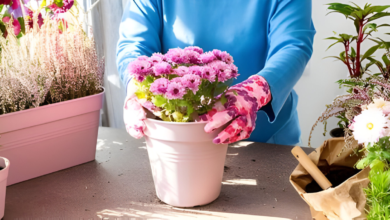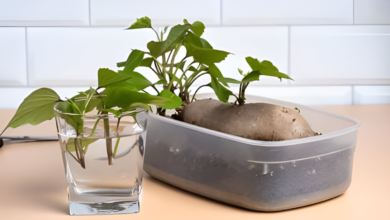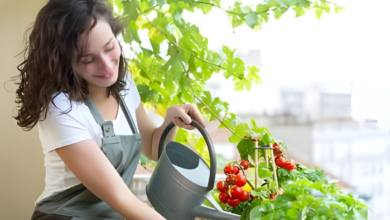Enhance Your Garden with Beautiful Flower Pots

Introduction
Gardening is not just about nurturing plants; it’s about creating a harmonious and inviting space that brings joy and tranquility. One way to elevate the beauty of your garden is by using beautiful flower pots. These versatile and decorative containers serve as the perfect backdrop to showcase your plants and add a touch of elegance to any outdoor space. In this blog post, we will explore the importance and benefits of using flower pots in gardening, discuss how to choose the right pots for your plants, and provide creative ideas to enhance your garden’s style.
Importance of Flower Pots in Gardening
Flower pots play a crucial role in gardening for several reasons. Firstly, they allow you to cultivate plants in limited spaces such as balconies, patios, or small yards. By utilizing pots, you can create a garden oasis regardless of your available space. Secondly, flower pots provide mobility, allowing you to move your plants to different locations to optimize sunlight exposure or protect them from harsh weather conditions. Lastly, they act as a protective barrier, safeguarding your plants’ roots from extreme temperatures and potential pests.
Benefits of Using Beautiful Flower Pots
Using beautiful flower pots enhances the overall aesthetic of your garden and creates a visually appealing landscape. These pots act as decorative elements that add charm and character to your outdoor space. By incorporating stylish pots, you can elevate the visual impact of your plants and create a more pleasing environment for you and your guests to enjoy. Moreover, beautiful flower pots can also serve as focal points, drawing attention to specific areas of your garden and guiding the viewer’s visual journey.
Creating a Welcoming and Vibrant Garden Atmosphere
Imagine walking through a garden filled with colorful and well-arranged flower pots. The vibrant hues and captivating designs create a welcoming and joyful atmosphere, instantly uplifting your mood. Flower pots offer endless possibilities to express your creativity and personal style. Whether you prefer a classic, rustic, or contemporary look, you can curate a garden ambiance that reflects your taste and personality. So, let’s delve into the different aspects of choosing and utilizing flower pots to enhance your garden.
Choosing the Right Flower Pots
Considerations for Material Selection
When selecting flower pots, you must consider the material they are made of. Three common options are terracotta, ceramic, and plastic. Each has its advantages and unique characteristics.
Terracotta Pots: Traditional Elegance and Breathability
Terracotta pots are renowned for their traditional elegance and timeless appeal. They are made from natural clay and have a porous nature, allowing for better air circulation and preventing soil from becoming waterlogged. Additionally, the terracotta material provides insulation, protecting plants from extreme temperatures.
Ceramic Pots: Versatile and Chic
Ceramic pots come in a wide range of sizes, colors, and designs, making them highly versatile for various garden styles. Their smooth and glossy finish adds a touch of sophistication to any outdoor space. Ceramic pots are also known for retaining moisture, making them ideal for plants that require a consistent level of hydration.
Plastic Pots: Lightweight and Durable
If you prioritize convenience and durability, plastic pots are an excellent choice. They are lightweight, making them easy to move around, and they are resistant to breakage. Plastic pots also come in a variety of vibrant colors and designs, allowing you to match them with your garden’s theme. However, keep in mind that plastic pots may require additional measures for proper drainage.
Determining the Appropriate Size of Flower Pots
Choosing the right pot size for your plants is crucial for their growth and overall well-being. Let’s explore some guidelines to follow when determining the appropriate size of flower pots.
Matching Pot Size with Plant Types
Different plant types have varying space requirements for their roots. It’s essential to research and understand the needs of the plants you are working with. For instance, plants with larger root systems, such as trees or shrubs, will require bigger pots to accommodate their growth. On the other hand, small herbs or flowers can thrive in smaller pots.
Maximizing Plant Growth with Proper Pot Size
Providing your plants with ample space is fundamental for their growth and development. If the pot is too small, the roots can become crowded, leading to poor nutrient absorption and stunted growth. Conversely, excessively large pots can cause water retention issues and restrict root growth. Thus, selecting an appropriate pot size ensures that your plants have the ideal environment to flourish.
Factors Influencing the Pot Size Decision
Several factors influence the decision of pot size, such as the expected growth rate of the plant, its ultimate size, and the available space in your garden. Additionally, consider the aesthetic aspect when selecting pot sizes, as arranging pots of different sizes can create visual interest and depth in your garden landscape.
Complementing Your Garden Style with Flower Pots
Exploring different pot styles and shapes
Choosing the right pot style and shape is essential for creating a cohesive and visually pleasing garden design. Let’s explore some popular pot styles and their characteristics.
Classic Round Pots: Timeless Elegance
Classic round pots are a timeless choice that exude elegance and simplicity. They are versatile and can fit into any garden style, from traditional to contemporary. These pots work well in arrangements of varying sizes, providing a harmonious balance to your garden.
Rectangular Trough Pots: Sleek and Modern
If you prefer a sleek and modern look, rectangular trough pots are an ideal option. They are perfect for creating linear arrangements along walkways or when placed against walls. Rectangular pots allow for multiple plants to be displayed together, offering the opportunity to create stunning combinations.
Hanging Baskets: Utilizing Vertical Space
Hanging baskets are an excellent choice for those with limited space or for adding vertical interest to your garden. They can be suspended from pergolas, fences, or tree branches, creating a cascade of colors and textures.
Selecting Colors and Patterns for Flower Pots
The color and pattern of your flower pots can significantly impact the overall aesthetic of your garden. Let’s explore some tips for selecting colors and patterns that will enhance your outdoor space.
Harmonizing with the surrounding environment
To create a harmonious look, consider the colors already present in your garden. Select flower pots that complement the existing color palette, whether by matching or creating a pleasing contrast. Harmonizing the colors of your pots and plants with the surrounding environment creates a cohesive and balanced appearance.
Using Contrasting Colors for Eye-catching Displays
If you desire an eye-catching display, opt for contrasting colors that make your flower pots stand out. For example, placing vibrant yellow pots against a backdrop of lush green foliage creates a dramatic effect. Contrast adds visual interest and ensures your flower pots become focal points in the garden.
Incorporating Patterns and Textures for Visual Interest
Patterns and textures on flower pots can add depth and intrigue to your garden. Consider pots with embossed patterns or textured surfaces to create an engaging visual experience. Additionally, patterns can be an excellent way to tie your pots together and create a cohesive look.
Creating a Cohesive Look with Multiple Flower Pots
Arranging multiple flower pots can transform a garden from ordinary to extraordinary. Let’s explore some ideas to create a cohesive look using multiple pots.
Grouping Pots of Varying Heights
Grouping pots of varying heights adds dimension and visual interest to your garden. By creating staggered arrangements, you can showcase different plants at various heights, creating a dynamic display. This technique is particularly effective when used along walkways or near seating areas.
Considering Symmetry or Asymmetry
The arrangement of your flower pots can follow either a symmetrical or asymmetrical pattern, depending on your desired garden style. Symmetrical arrangements offer a formal and balanced look, while asymmetrical arrangements create a more relaxed and natural feel. Choose a style that best suits your preferences and complements your garden’s overall design theme.
Mixing and matching different pot styles
Mixing and matching different pot styles can add an element of surprise and individuality to your garden. Experiment with blending classic round pots, rectangular trough pots, and hanging baskets to create a diverse and visually appealing arrangement. Don’t be afraid to get creative and let your personal style shine through.
Enhancing Your Plants with Creative Pot Arrangements
Layering Plants for Height and Texture
Layering plants in your flower pots allows you to create beautiful combinations of colors, heights, and textures. Here are some tips for achieving stunning effects.
Choosing Thrillers, Fillers, and Spillers
When designing a pot arrangement, consider the concepts of thrillers, fillers, and spillers. Thrillers are tall and eye-catching plants that serve as the centerpiece. Fillers are medium-sized plants that add fullness and texture to the arrangement. Spillers are trailing or cascading plants that gracefully overflow the pot’s edges, adding depth and softness. By combining these three categories, you can create captivating visual displays.
Creating beautiful cascading effects
Cascading plants are perfect for adding a touch of elegance and drama to your pot arrangements. Plants like trailing ivy, sweet potato vinegar, or creeping Jenny can gracefully spill over the edges of the pot, creating a cascading effect. This technique is particularly effective for hanging baskets or pots placed on elevated surfaces.
Combining Different Foliage Types and Colors
Experimenting with different foliage types and colors allows you to create visually stunning pot arrangements. Combine plants with contrasting leaf shapes, sizes, and colors to achieve striking effects. For example, pairing vibrant flowers with variegated foliage can create a captivating contrast in color and texture.
Incorporating accessories and decor
Enhance your pot arrangements further by incorporating accessories and décor elements. Here are some ideas to personalize your flower pots.
Adding Trellises and Supports
Trellises and supports are perfect additions to climbing or vining plants, adding height and structure to your pot arrangements. They provide additional support for the plants’ growth and create a visually pleasing vertical element in your garden. Explore different styles and materials, such as bamboo or metal, to find the perfect match for your overall garden design.
Using Plant Stands and Risers
Elevating your flower pots with stands or risers is an effective way to create visual interest and add depth to your garden. Plant stands allow you to showcase your plants at different heights, creating a tiered effect. Look for stands or risers that complement your pot styles and colors for a cohesive and polished look.
Incorporating Decorative Elements for Personalization
Infuse your personality and creativity by incorporating decorative elements into your pot arrangements. Consider adding colorful garden stakes, decorative stones, or whimsical figurines that align with your garden style. These details can spark conversation and bring a touch of whimsy to your outdoor space.
Maintaining Healthy Plants in Flower Pots
Providing adequate drainage and watering
Proper drainage is essential for the health of your plants in flower pots. Ensure that your pots have drainage holes at the bottom to prevent waterlogging. Additionally, use well-draining soil and water your plants adequately, allowing excess water to drain away. Regularly check the moisture levels of the soil to avoid overwatering or underwatering.
Using Proper Soil and Fertilization
Different plants require specific soil types to thrive. Choose a potting mix formulated for your plant’s needs, ensuring it provides the necessary nutrients and proper moisture retention. Fertilize your plants regularly using organic or slow-release fertilizers to promote healthy growth.
Protecting Plants from Extreme Temperatures and Pests
Flower pots offer a level of protection for your plants, but it’s still essential to shield them from extreme temperatures and pests. During harsh weather conditions, consider moving your pots to more sheltered areas. Additionally, monitor your plants for signs of pests, such as aphids or mealybugs, and take appropriate measures to prevent infestations.
Summary and Frequently Asked Questions (FAQs)
Recap of the Benefits of Beautiful Flower Pots
In summary, using beautiful flower pots in your garden offers numerous benefits. They allow you to utilize limited space, provide mobility, and act as a protective barrier for your plants. Moreover, they enhance the overall aesthetic of your garden, create a welcoming atmosphere, and serve as focal points or visual elements.
Answers to Common Queries about Flower Pot Gardening
How often should I water plants in flower pots?
The frequency of watering your plants in flower pots depends on various factors, such as plant type, pot size, and weather conditions. As a general rule, check the soil moisture regularly and water when the top inch feels dry. Avoid overwatering, as it can lead to root rot.
Can I leave flower pots outside during the winter?
The answer depends on the plant species and your climate. Some plants are more tolerant of cold weather, while others may require protection. Consider the hardiness zone of your region and the specific requirements of your plants. If needed, you can provide insulation or move the pots indoors during freezing temperatures.
What are some low-maintenance plants suitable for flower pots?
Several low-maintenance plants are ideal for flower pots, making them perfect for novice gardeners or those with limited time. Some examples include succulents, such as jade plants or aloe vera; herbs like rosemary or thyme; and sturdy perennials like lavender or black-eyed Susan.
Incorporating beautiful flower pots into your garden can transform it into a captivating oasis. From choosing the right pots to creative arrangements and maintenance tips, you now have the knowledge to enhance your garden’s beauty. Embrace your creativity, explore different styles, and let your garden shine with the charm of beautiful flower pots. Happy gardening!




